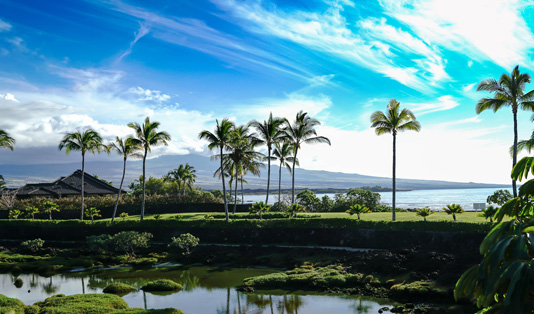
Big Island
The island of Hawaii is the youngest and largest island in the Hawaiian chain. Nearly twice as big as all of the other Hawaiian Islands combined (hence, its nickname, “Big Island”), its sheer size is awe-inspiring. You can travel through all but four of the world’s different climate zones here, ranging from Wet Tropical to Polar Tundra, a result of the shielding effect and elevations of the massive volcanoes Maunakea and Maunaloa. From the many geological features at Hawaii Volcanoes National Park to the snow-capped heights of Maunakea; from the lush valleys of the Hilo and Hamakua Coasts to the jet-black sands of Punaluu Beach, the island of Hawaii is an unrivaled expression of the power of nature.
Hamakua Coast
Located just north of Hilo on the northeastern side of the island of Hawaii, the Hamakua Coast is one of the most beautiful stretches of scenery on the island. With nearly 84 inches of rainfall a year, the region boasts lush tropical rainforests, stunning waterfalls and tranquil green valleys.
During most of the 19th and 20th centuries, the Hamakua Coast was covered with sugar cane. Today, communities can still be found where small farmers grow kalo (taro), hearts of palm, vegetables and tropical fruit. Small towns like Historic Honokaa Town also feature specialty shops and boutiques with their own local flavor.
Hilo
Located on the northeastern side of the island of Hawaii, Hilo offers breathtaking natural beauty plus all the amenities of a vibrant town. On the geographic flipside of the volcanic Kohala Coast, the region is blessed with dramatic waterfalls, fertile rainforests and blooming gardens.
A busy farming and fishing area in early times, Hilo evolved into a commercial center for the sugar industry in the 1800s. Downtown Hilo was built around its crescent-shaped bay and became the seat of county government. Today, Downtown Hilo is a charming town offering museums, art galleries, shops and restaurants.
Puna
South of Hilo on the island of Hawaii’s easternmost tip lies the Puna district and town of Pahoa, known for its free-spirited vibe. Many locals believe that Puna is Pele’s workshop, where the volcano goddess continually creates and recreates the very land we live on. Indeed, this dynamic area stretches from Kilauea’s summit east to the sea, including lava features, black-sand beaches and more natural wonders forged by the power of volcanoes.
Kau
Vast, rural and remote, the island of Hawaii’s southernmost region, Kau, is a quiet area free of large hotels, resorts and golf courses. It’s home to the small communities of Naalehu and Pahala, and one of the most famous beaches in the state—Punaluu Black Sand Beach.
Kau is also home to most of Hawaii Volcanoes National Park and Kilauea, one of the world’s most active volcanoes. It’s a place of natural wonders where you can witness the growth of the island right before your eyes. Other sights in Kau include Kalae, known as South Point, the southernmost point in the United States, and Kau Desert, which is on southwest edge of Kilauea. Here you’ll find footprints of warriors who were trapped in volcanic ash long ago — a result of one of Kilauea’s rare explosive eruptions. This area is also popular among backpackers and hikers, as taxing trails crisscross the land from the mountains to the sea.
In contrast, on the eastern slopes of Kau, there are macadamia nut orchards, coffee farms and cattle. Wood Valley, near Pahala, is a place for meditation and respite from the outside world. It’s no wonder Kau is home to not only Hawaiian families who have been here for generations, but also writers, artists, philosophers and others seeking solitude.
Kona
The sunny Kona District stretches almost two-thirds of the entire West side of the island of Hawaii—from just south of Anaehoomalu Bay (Waikoloa Beach Resort) to Manuka Park (Kau). Along this expansive area, you’ll find everything from coffee farms to historic Hawaiian landmarks. In fact, King Kamehameha actually spent his final years in Kailua-Kona.
Shielded from winds by Maunaloa, south Kona’s calm and clear waters are perfect for snorkeling, diving, sailing and spotting dolphins and honu (Hawaiian green sea turtles). One of Kona’s most memorable experiences is going on a manta ray boat tour to scuba or snorkel with these gentle, graceful sea creatures. Kona is also famous for its deep-sea fishing, hosting the International Billfish Tournament (August) every year.
Kohala
As you drive 20-minutes north of Kona International Airport, you’ll marvel at the rugged lava fields surrounding you. You may not see it from Queen Kaahumanu Highway, but the Kohala Coast is where you’ll find some of the island’s finest resorts. Nestled amongst the jet-black and rust-red lava rock fields, a result of eruptions from the island’s volcanos centuries ago, are green oases full of world-class accommodations, fine dining and some of Hawaii’s best golf courses. The sun-drenched Kohala Coast sees an annual average rainfall of only nine inches, so soak in the sun and relax at Hapuna Beach State Park, one of the island of Hawaii’s largest white sand beaches, indulge at local restaurants or recharge at a local spa. You’ll discover cultural treasures on the Kohala Coast, too, such as the remarkable Puukohola Heiau National Historic Site, the largest restored heiau in Hawaii.
At the junction of Kawaihae Road and Highway 19, turn east to explore the cool scenic pasturelands of Waimea. In sharp contrast to the lava landscapes along the Kohala Coast, this upcountry town is home to the paniolo (Hawaiian cowboy).
Sorry we are experiencing system issues. Please try again.

